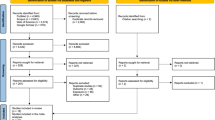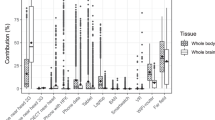Abstract
For 30 years, there have been suggestions that extremely low frequency magnetic fields such as those are produced by electric power systems may be associated with elevated risks of childhood leukemia. These suggestions are driven by epidemiological evidence, and it has been common to characterize that evidence as showing a threshold effect, with no increase in risk below a threshold, often 0.3 or 0.4 μT, and a constant risk above it. Such a threshold would, however, be biologically unlikely. We tested alternative dose–response relationships quantitatively. We obtained five exposure data sets, applied several candidate dose–response relationships to each one, and performed a regression analysis to see how well they fit each of the three epidemiological data sets. Threshold dose–response relationships performed only moderately. Linear relationships were generally even poorer. The fit was improved by adding quadratic terms or performing non-linear regression. There are limitations in our analysis, stemming from the available data, but addressing this issue in a data-based, quantitative manner should improve understanding, allow better calculations to be made of attributable numbers, and hence ultimately inform public policy making.
This is a preview of subscription content, access via your institution
Access options
Subscribe to this journal
Receive 6 print issues and online access
$259.00 per year
only $43.17 per issue
Buy this article
- Purchase on Springer Link
- Instant access to full article PDF
Prices may be subject to local taxes which are calculated during checkout

Similar content being viewed by others
References
Ahlbom A., Day N., Feychting M., Roman E., Skinner J., and Dockerty J., et al. A pooled analysis of magnetic fields and childhood leukaemia. Br J Cancer 2000: 83: 692–698.
Brix J., Wettemann H., Scheel O., Feiner F., and Matthes R. Measurement of the individual exposure to 50 and 16? Hz magnetic fields within the Bavarian population. Bioelectromagnetics 2001: 22: 323–332.
Foliart D.E., Pollock B.H., Mezei G., Iriye R., Silva J.M., Ebi K.L., Kheifets L., Link M.P., and Kavet R. Magnetic field exposure and long-term survival among children with leukemia. Br J Cancer 2006: 04: 161–164.
Forssén U.M., Ahlbom A., and Feychting M. Relative contribution of residential and occupational magnetic field exposure over twenty-four hours among people living close to and far from a power line. Bioelectromagnetics 2002: 23 (3): 239–244.
Greenland S. Estimation of population attributable fractions from fitted incidence ratios and exposure survey data, with an application to electromagnetic fields and childhood leukemia. Biometrics 2001: 57 (1): 182–188.
Greenland S., and Kheifets L. Leukemia attributable to residential magnetic fields: results from analyses allowing for study biases. Risk Analysis 2006: 26: 471–481.
Greenland S., Sheppard A.R., Kaune W.T., Poole C., and Kelsh M.A. A pooled analysis of magnetic fields, wire codes, and childhood leukemia. Epidemiology 2000: 11: 624–663.
Gurney J.G., Severson R.K., Davis S., and Robison L.L. Incidence of cancer in children in the United States. Cancer 1995: 75: 2186–2195.
IARC, Non-Ionizing Radiation, Part 1: Static and Extremely Low-Frequency (ELF) Electric and Magnetic Fields. Monographs of the Evaluation of Carcinogenic Risks to Humans. International Agency for Research on Cancer, Vol. 80, 2002.
Kheifets L., Afifi A, and Shimkhada R. Public health impact of extremely low frequency electromagnetic fields. Environ Health Perspect 2006: 114 (10): 1532–1537. 10.1289/ehp.8977.
Mills K., Kheifets L., Nelson L., Bloch D., Takemoto-Hambleteon R., and Kelsey J. Reliability of proxy-reported and self-reported household appliance use. Epidemiology 2000: 11 (5): 581–588.
Schüz J., Svendsen A., Linet M., McBride M., Roman E., Feychting M., Kheifets L., Lightfoot T., Mezei G., Simpson J., and Ahlbom A. Night-time exposure to electromagnetic fields and childhood leukemia: an extended pooled analysis. Am J Epidemiol 2007: 166 (3): 263–269.
Swanson J., and Kaune W.T. Comparison of residential power-frequency magnetic fields away from appliances in different countries. Bioelectromagnetics 1999: 20 (4): 244–254.
Swanson J., and Kheifets L. Biophysical mechanisms: a component in the weight of evidence for the health effects of power-frequency electric and magnetic fields. Radiat Res 2006: 165 (4): 470–478.
World Health Organization Environmental Health Criteria (WHO EHC): Extremely Low Frequency Electromagnetic Fields, No. 238, 2007.
Zaffanella L.E., and Kalton G.W. Survey of Personal Magnetic Field Exposure. Phase I: Pilot Study and Design of Phase II. RAPID Engineering Project #6. Enertech, for Oak Ridge National Laboratory EMF Research Program. US Department of Energy, 1998a.
Zaffanella L.E., and Kalton G.W. Survey of Personal Magnetic Field Exposure. Phase II: 1000-Person Survey. Interim Report. RAPID Engineering Project #6. Enertech, for Oak Ridge National Laboratory EMF Research Program. US Department of Energy, 1998b.
Acknowledgements
We thank Energy Networks Association (ENA) for funding this work. We also thank Ruediger Matthes and ENERTECH Consultants for making exposure data available.
Author information
Authors and Affiliations
Corresponding author
Ethics declarations
Competing interests
Energy Networks Association (ENA) funded this work. The only condition of ENA funding this work was that the results should be published openly in reputable, peer-reviewed scientific journals and they had no influence over the conduct or results of the study. J Swanson worked on this paper with permission from the National Grid, but no results were shared nor was approval sought from anyone in the National Grid, and the views expressed are his alone.
Rights and permissions
About this article
Cite this article
Kheifets, L., Afifi, A., Monroe, J. et al. Exploring exposure–response for magnetic fields and childhood leukemia. J Expo Sci Environ Epidemiol 21, 625–633 (2011). https://doi.org/10.1038/jes.2010.38
Received:
Accepted:
Published:
Issue Date:
DOI: https://doi.org/10.1038/jes.2010.38
Keywords
This article is cited by
-
Indoor transformer stations and ELF magnetic field exposure: use of transformer structural characteristics to improve exposure assessment
Journal of Exposure Science & Environmental Epidemiology (2014)
-
Potential impacts of radon, terrestrial gamma and cosmic rays on childhood leukemia in France: a quantitative risk assessment
Radiation and Environmental Biophysics (2013)



